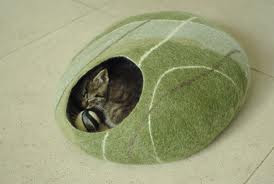I have been needle felting for a bit now(you can see some of my work
here)..and thought I would try wet felting. It's a much different process then needle felting.
The way wet felting works is you layer drafts of roving(about 4-8 layers) on to bubble wrap.
cover your piece with tulle fabric and wet it carefully with hot soapy water.
Rubbing gently as the piece gets wet and soapy, then more vigorously.
Every few minutes carefully remove the tulle and replace also making sure you turn the piece over to get both sides. That is the 'felting' process. Then begins the 'fulling' process.
You roll the wet piece up in the bubble wrap, tulle, and bamboo mat.
and roll it, and roll it, and roll it, opening it up every few minutes to change direction and check it.
Finally you rinse in hot water, then cold. Squeezing out the water, blotting on a towel and rolling it flat with a rolling pin.
Here are some photos I took during the process.
 |
| base layer of white and the design on top |
 |
| work area ready to go |
 |
| Hot soapy water at the ready |
 |
| piece covered in tulle, rubbing has commenced |
 |
| fulling the piece |
 |
| before rinsing, but finished |
 |
| drying |
 |
| the finished piece |
 |
| I lightly stitched to a store-bought piece of felt and hung. |
|
What do you think? Not too bad for my first effort. It's just a small piece, maybe next time I will go a little bigger.
Love to hear your comments!





































